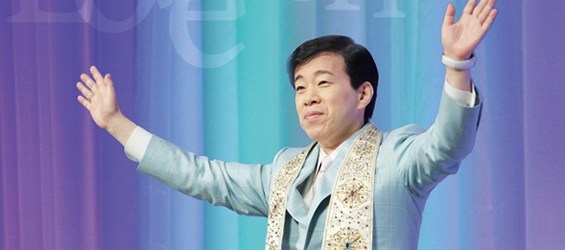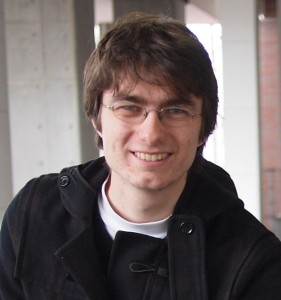Religious Authority in a Post-Religious Society
authority
|Japan
|New Religious Movements
|spiritual but not religious
February 19, 2015
Since the 1980s, social and economic pressures to stay within mainstream society have become more prominent, and spiritually minded individuals often seek more limited, loosely bonded participation in New Age-style modes of thought. The question of charismatic and spiritual authority has become ever more relevant in present day Japan, which is an exceedingly “non-religious but spiritual” nation.Share this response


By Avery Morrow
Avery Morrow is soon to begin work at the University of Tokyo’s Department of Religious Studies researching a modern spiritualist movement. His studies of various aspects of Japanese traditionalism have been published in the Wittenberg University East Asian Studies Journal and Innovative Research in Japanese Studies. His book-length literary analysis The Sacred Science of Ancient Japan was published in 2014.
In response to:
February 16, 2015
Religion and Authority in Asia
Given its contextual and perspectival malleability, the notion of ‘authority', and even more so of ‘religious authority’, is challenging to define and to study. In today’s interview with Paulina Kolata, Dr Erica Baffelli discusses the notion of authority and charismatic leadership in the context of her research on New and ‘New’ New religions in contemporary Japan.
Audio Player
00:00
00:00
Use Up/Down Arrow keys to increase or decrease volume.
Podcast: Play in new window | Download
Subscribe: RSS
The question of charismatic and spiritual authority has become ever more relevant in present day Japan, which is an exceedingly “non-religious but spiritual” nation. In her interview, Dr. Erica Baffelli introduces us to a wide variety of perspectives on creating, distributing, maintaining and defending religious authority that can be found within Japanese new religious movements (NRMs). Japanese religious leaders operate in a complex social landscape in which they must constantly maneuver between tradition and modernity, specificity and universalism, nation and world, in their quest for legitimacy. The variety of approaches that can be found among NRMs, and the persistence of non-Western views of history and ritual that call the applicability of the category “religion” into question, make the country’s religious landscape difficult to characterize, but Dr. Baffelli does an admirable job of summarizing some major avenues of study into Japanese religious authority.
As Dr. Baffelli and her interviewer describe, religious authority in Japan can be analyzed through categories such as space, body, text, politics, media, and technology. The differences between Japanese and Western formations of these subjects, as well as the diversity within Japan, can help shed light on the assumptions we make about how authority is acquired and asserted. For example, Western understandings of religious text are closely linked to the concept of a “scripture,” a divinely inspired, normative document. But Japan has traditionally had many different kinds of religious text, which are not necessarily considered inspired or treated as normative. Japanese NRMs offer us many different ways to derive authority from a text.
Dr. Baffelli points to a recent article by Clark Chilson, “Cultivating Charisma: Ikeda Daisaku’s Self Presentations and Transformational Leadership”, which is an excellent study of the Sōka Gakkai leader’s use of text, primarily the roman à clef epic Human Revolution, to distribute authority to his readers. As Chilson describes it, Ikeda’s readers are apprentices as he once was. They have been initiated into his path to the Truth and are now striving to mature their own capacities for leadership. Ikeda’s text describes how his authority was not granted to him exclusively, but was acquired through experience and can be passed on to any Gakkai member. Ikeda is thus preparing the Gakkai to manage institutional authority and power long after he himself is gone.
Ikeda’s magnum opus makes for a sharp contrast with the texts of Ōkawa Ryūhō, founder of the NRM called, in English, Happy Science. Ōkawa’s many speeches and books make it evident that his authority belongs to him alone, through his hidden identity as God the Father, and cannot be acquired by anyone else. Ōkawa’s ability to expound on the past and future of humanity, and to channel the higher spirit of any human or extraterrestrial being, living or dead, makes reading his books a lesson in simple “awareness” of his omniscience, not an instruction manual for those who would want to maintain his sect in future generations.
The bumpy transition from charismatic to institutional authority has been a key turning point in many Japanese NRMs. Dr. Baffelli states that many groups find comfortable rule by a group of experienced members to be preferable to a continuation of unruly charismatic leadership. But the sudden loss of a charismatic leader just as frequently causes an NRM to lose its direction and unity. In a 2007 article, “Shifting Paradigms and Mediating Media,” Christal Whelan described how an NRM called God Light Association underwent radical changes and splits following the loss of its leader, Takahashi Shinji. Members in Osaka continued to revere Takahashi by watching videos of his glossolalic interpretations, while members in Tokyo reorganized around his daughter Keiko , who rebuilt the group into a completely different therapeutic program. Still other members joined Ōkawa Ryūhō at Happy Science, or another NRM known as Pana Wave Laboratory.
A notable point made at the end of this interview deserves the attention of scholars of religion. Since the 1980s, the innumerable thousands of organized Japanese NRMs, called shinshūkyō in Japanese, have been losing members. The 1995 sarin gas attacks on the Tokyo subway by Aum Shinrikyō, an esoteric NRM which had attracted the support of several Japanese religious scholars, certainly hastened criticism of NRMs in public discourse, but the trend away from NRMs did not begin with Aum. Since the 1980s, social and economic pressures to stay within mainstream society have become more prominent, and spiritually minded individuals more often seek more limited, loosely bonded participation in New Age-style modes of thought, dubbed “new spirituality movements” by Shimazono Susumu (c.f. Shimazono 2004).
But questions of charismatic, spiritual, and institutional authority remain with us. The scholarly work on NRMs is by no means outdated, but, in fact, is increasing in relevance as we try to make sense of Shimazono’s NSMs. From crystal healing and Reiki, to millenarian “ascension,” to attendance at shrines, to therapeutic forms of mass communication, NSMs are everywhere in 21st century Japan, and with them come new questions about how spiritual institutions can aid the bricoleurs who wander their way, and what sort of authority is possible in such loosely connected interactions.
In his book, “Spiritual” wa naze hayaru no ka, journalist Isomura Kentarō offers the counterintuitive but revealing example of an e-mail list and blog run by former video game designer Itoi Shigesato, which offers self-help advice and pick-me ups to roughly a hundred thousand subscribers every day. Readers are devoted to the heartwarming writings of Itoi, who is affectionately dubbed “Darling,” but when they bring up his blog posts in everyday life, they frequently get the impression of being perceived as adherents of a religious cult. Having discovered his charismatic authority, Itoi now has the full-time job of delicately managing a small media empire while avoiding the stain of religiousness. He aims to produce messages and physical products (most notably, a fancy notebook called the Hobonichi Planner) that readers will enjoy, but not to draw them in as closely as an NRM leader would have done.
A similar phenomenon is happening even in overtly spiritual movements. I will soon begin a study of a loose network of readers of the channeled text Hitsuki Shinji. After being the focus of two NRMs in the postwar years, the lengthy text was virtually abandoned until the 1990s, when the writer Nakaya Shin’ichi began publishing dozens of books offering a spiritually minded exegesis. But until this year, Nakaya’s interactions with his readers have been limited to a monthly magazine and public talks. Similar to Itoi’s mailing list, the text has been offered as a direct reading experience unmediated by any organization, and its implementation has been essentially left to the individual. But starting this spring, Nakaya intends to take the risk of forming a more tight-knit group and asserting authority as the text’s chief interpreter. Can an NSM be transformed into an NRM? The answer to this will be found in the complex social landscape of modern religious authority.
References
Chilson, Clark. 2014. “Cultivating Charisma: Ikeda Daisaku’s Self Presentations and Transformational Leadership” Journal of Global Buddhism, vol. 15, pp. 65-78
Isomura Kentarō. 2010. “Spiritual” wa naze hayaru no ka. PHP Kenkyūjo.
Whelan, Christal. 2007. “Shifting Paradigms and Mediating Media: Redefining a New Religion as ‘Rational’ in Contemporary Society.” Nova Religio, vol. 10, no. 3, pp. 54-72
Shimazono Susumu. 2004. From Salvation to Spirituality: Popular Religious Movements in Modern Japan. Trans Pacific Press.
=================
Fund the RSP while you shop! Use an Amazon.co.uk, Amazon.ca, or Amazon.com affiliate link whenever you make a purchase. There’s no additional cost to you, but every bit helps us stay on the air!
We need your support!
Want to support us directly? Become a monthly Patron or consider giving us a one-time donation through PayPal.
OTHER EPISODES YOU MIGHT ENJOY

Founding American Religion, the Journal
Podcast
Find out about the founding of the new journal American Religion with editors Sarah Imhoff and Cooper Harris

Ecospirituality, Gender and Nature
Podcast
Is, as Sherry Ortner once asked, Female to Nature as Male is to Culture? Where does this discourse come from? How does this gendering of nature intersect with contemporary forms of ecospirituality? And religion more generally? Why does it matter? And for whom? Joining Chris today to discuss these questions and more, is Dr Susannah Crockford of Ghent University.

Rudolf Otto
Podcast
Rudolf Otto was a highly influential figure in the history of Religious Studies, but whether that influence was for good or not is a debatable issue. His ideas about the sui generis nature of the religious experience and of an irreductible numinous or sacred foreshadow the work of scholars such as Eliade, but proved highly divisive for scholars and practitioners alike.

Pilgrimage in Japan and Beyond: Part 2
Podcast
Professor Ian Reader discusses his publication ‘Pilgrimage in the Marketplace’, which explores the very ‘worldly’ conditions of development, popularisation, and ultimately, survival of pilgrimage centres in connection to the dynamics of the marketplace through which the ‘sacred’ as a category can be sustained.

Brian Victoria on Zen Buddhist Terrorism and Holy War
Podcast
Is there something particular about religion which makes it a more potent ‘violence enabling mechanism’ than other factors? Are some religions more likely to inspire violence than others? And why should scholars even care? In this interview, Chris discusses these issues and more with Professor Brian Victoria, who, in addition to his scholarly credentials, is a fully ordained Zen Buddhist priest.

Carl Jung
Podcast
Carl Gustav Jung (1875-1961) was a Swiss psychiatrist. Initially a collaborator with Sigmund Freud, the two later split and Jung went on to found the Analytical Psychology school of psychotherapy. His approach focussed on what he called the process of individuation, ...
